
|
|
The World of Stonehenge
|
July 23, 2010
|
|
|

Stonehenge (Wikimedia Commons)
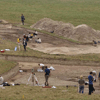 The Henge Builders: New discoveries inspire archaeologists to re-envision the culture that created Stonehenge
The Henge Builders: New discoveries inspire archaeologists to re-envision the culture that created Stonehenge
In 1856, American writer Nathaniel Hawthorne hired a carriage for a 10-mile journey from the rural town of Salisbury to Stonehenge. Of the great megaliths he wrote, "There never was a ruder thing made by mortal hands as if Nature and man had worked upon it with one consent, and so... all the stranger and more impressive from its rudeness."
Some 150 years later I'm following Hawthorne's route across Salisbury Plain, along a rough track that opens onto sweeping fields and skies. I can see Stonehenge less than a mile away, on a gently sloping spur, dwarfed by surrounding hills. There, massive blocks of sarsen sandstone rise 17 feet, encircling even larger sarsen stones and rings of bluestones up to eight feet high that had been transported more than 200 miles from the Preseli Hills in Wales. Scattered around the landscape are earthen mounds 12 or more feet high, covering the Bronze Age graves of people once thought to have built the mysterious monument.
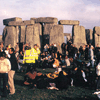 Solstice at the Stones: For Britain's modern-day pagans, sites like Stonehenge are sacred ground
Solstice at the Stones: For Britain's modern-day pagans, sites like Stonehenge are sacred ground
I get my first glimpse of Stonehenge while mired in a five-mile traffic jam. It's just after midnight, a few hours before sunrise on summer solstice, the longest day of the year. From my car, I can see the familiar stones bathed in an eerie blue light that gives the venerable monument the feel of an empty film set--though it won't be empty for long. I'm one of 30,000 people hoping to see the sun rise over the stones.
 Amesbury's Bronze Age Archer
Amesbury's Bronze Age Archer
Well, it's a good headline for a tabloid newspaper!" said Andrew Fitzpatrick when asked about the "King of Stonehenge" rumors surrounding Britain's richest Early Bronze Age burial found in May near Amesbury, about three miles southeast of Stonehenge. "I plead guilty as charged of trailing [the moniker] to the newspapers," said Fitzpatrick, the project manager for Wessex Archaeology. "But this was clearly an elder in the community, perhaps even a king or tribal leader. He would have lived near Stonehenge and other great religious sites in the vicinity at about the time the stone circles were erected."
New Stones at Avebury
A new series of slabs at Avebury stone circle in western England, discovered under a farmer's field, probably formed a causeway linking the circle, or henge, to a contemporary burial site at Beckhampton, a mile to the southwest. University of Leicester and Southampton archaeologists now believe that the complex, whose main circle was last excavated in 1930, covered a much larger area than originally thought and was probably built in several stages.
The existence of buried avenues was first suggested in the 1720s by the English antiquarian William Stukeley, although many dismissed his theories as guesswork.
The French Built Stonehenge?
A British scholar has claimed that Stonehenge, England's most famous prehistoric monument, was built by the French. Aubrey Burl, author of numerous books on prehistoric stone monuments, says that several design features and carvings on one of the stones show clear links to megalithic sites in Brittany. Burl's theory has aroused skepticism among his colleagues, who doubt any real connection between the 4,500-year-old Stonehenge and older Breton megaliths.
Beyond Stonhenge
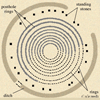 New Wood Henge
New Wood Henge
Remains of the largest timber henge ever found have been discovered at Stanton Drew, near Bristol, a site already famous for its three circles of standing stones. The new henge, detected during a magnetometer survey of the Great Circle, the largest of the stone monuments, has nine concentric rings of what look like postholes, each about three feet wide. The outermost ring is more than 300 feet in diameter, filling most of the area within the Great Circle, while the innermost ring is about 75 feet across. All told, there were probably between 400 and 500 posts.
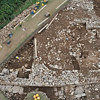 Orkney's Neolithic "Cathedral": The newly uncovered Structure 10
Orkney's Neolithic "Cathedral": The newly uncovered Structure 10
The Heart of Neolithic Orkney World Heritage Site, designated by UNESCO in 1999, includes a number of impressive monuments, such as Maeshowe, the largest chambered cairn on Orkney; the Standing Stones of Stenness, a henge monument 144 feet across; the Ring of Brodgar, another henge, 304 feet across and the third largest in Britain. These tightly clustered remains--Stenness and Brodgar are just a mile apart--are set on and near the Ness of Brodgar, a narrow strip of land separating Harray and Stenness lochs. It is a stunning setting. What more could you ask for?
Well, what they have is a huge, 5,000-year-old Neolithic complex.
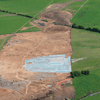 Lismullin Henge, Tara, Ireland
Lismullin Henge, Tara, Ireland
Early last year, archaeologists working on the route of a controversial highway near the village of Lismullin, Ireland, stumbled across a vast Iron Age ceremonial enclosure, or henge, surrounded by two concentric walls. The 2,000-year-old site is just over a mile from the Hill of Tara, traditional seat of the ancient Irish kings and site of St. Patrick's conversion of the Irish to Christianity in the fifth century A.D. The discovery of the massive henge, measuring more than 260 feet in diameter, confirms the long-held belief that the area around the hill contains a rich complex of monuments.

